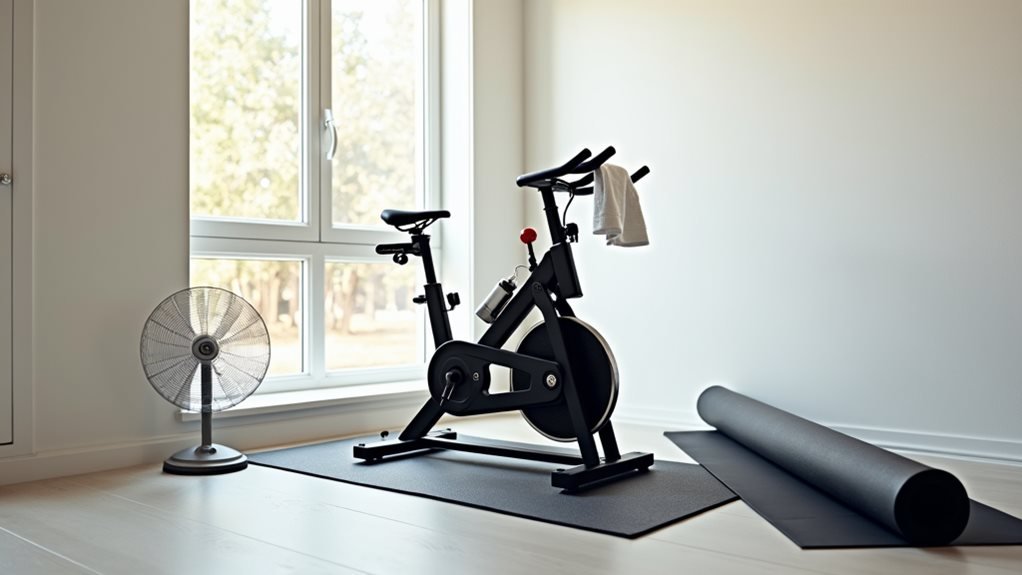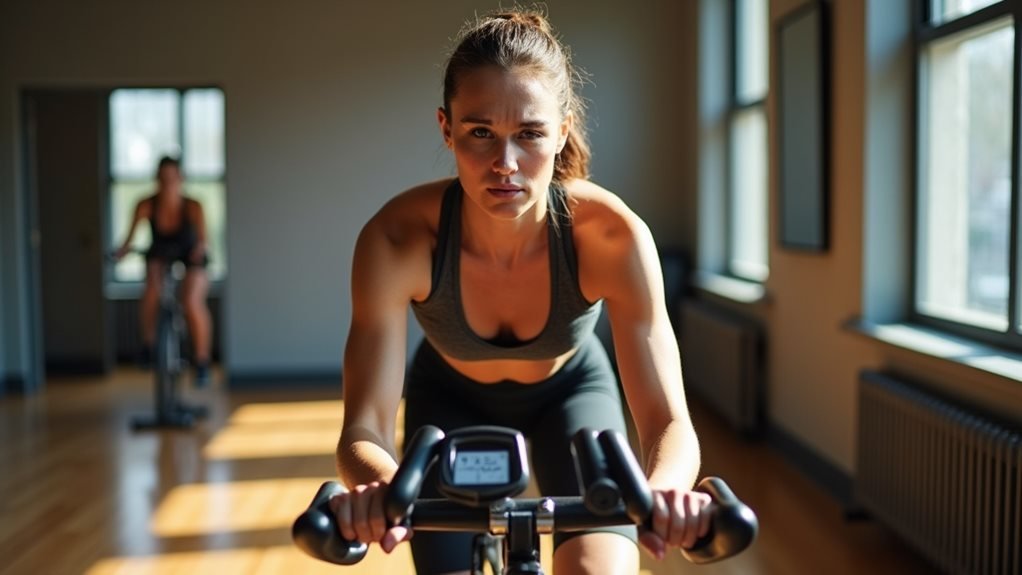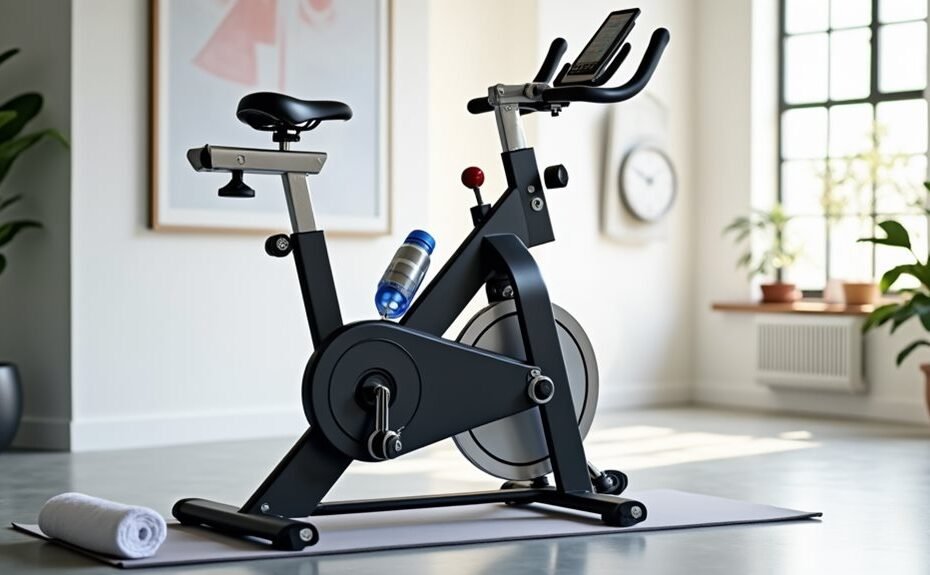Research shows that 45% of new static bike users abandon their fitness goals within the first month due to preventable discomfort and unrealistic expectations. I've spent years helping beginners navigate their first week on a static bike, and I can tell you that success depends largely on what you do before you even start pedaling. While it's tempting to jump right in and push yourself to the limit, there's a smarter approach that'll help you avoid the common pitfalls that derail so many newcomers. Let me share the essential steps that'll set you up for long-term success.
Some of the links in this article may be affiliate links. If you make a purchase through these links, we may earn a small commission at no extra cost to you. Thank you.
Key Takeaways
- Initial soreness in legs and seat area is normal during the first week as your body adjusts.
- Start with short 20-minute sessions at low resistance levels to build endurance gradually.
- Expect some difficulty maintaining proper form and consistent speed until you develop muscle memory.
- You may need several attempts to find the most comfortable bike setup for your body.
- Heart rate will spike quickly during early workouts as your cardiovascular system adapts to cycling.
Getting Your Body Ready
Getting on a static bike for the first time requires careful preparation to ensure a safe and effective workout. I'll tell you exactly how to set yourself up for success, starting with proper bike adjustment.
Set that seat at hip height when you're standing next to the bike – no exceptions. Your handlebars need to be at a distance where you're not stretching or cramping. Cycling shoes can help target specific leg muscles more effectively than regular sneakers.
Before you hop on, let's talk fuel. Eat a light meal 1-2 hours before your session – think carbs and protein, but don't stuff yourself. You'll want enough energy without feeling like you've got a brick in your stomach. And yes, you absolutely need to stay hydrated. HIIT stationary bike workouts can be particularly effective for maximizing your fitness potential.
Now, here's the essential part: proper form. I'm talking straight back, engaged core, and feet properly clipped in. If you're hunching, you're doing it wrong. Your body's about to work a serious array of muscles – from your glutes to your calves – so positioning matters. Adjusting the resistance levels helps challenge different muscle groups and increases calorie burn.
Trust me on this: take the time to adjust everything properly. Your muscles will thank you later, and you'll set yourself up for consistently better workouts from day one.
Setting Up Your Space

Let me walk you through the proper setup of your static bike – it's essential for both comfort and performance.
First, I'll have you adjust that saddle height. Stand next to your bike and align the seat with your hip bone. When you're seated, you'll want a slight bend in your knee at full extension – I'm talking about a 25-35 degree microbend. Before you start pedaling, make sure all knobs are securely locked to prevent any unwanted movement during your workout. Proper saddle positioning maximizes your power output while cycling.
Now, let's nail your positioning. Your knee should align perfectly with the pedal when it's at 3 o'clock. If it doesn't, slide that saddle forward or back until it does. Trust me, your joints will thank you later.
For the handlebars, I want your shoulders, elbows, and hips roughly in line. If you're new to this, keep those bars slightly above saddle height. Your elbows should have a gentle bend – no T-Rex arms or superman reaches.
Managing Initial Discomfort

While starting a new cycling routine is exciting, you'll likely experience some initial discomfort as your body adapts to this unfamiliar activity. I'll help you tackle the most common issues head-on, so you can focus on crushing your fitness goals.
First, let's address saddle discomfort – it's not fun, but it's fixable. Make sure your saddle's level and wear proper cycling shorts (without underwear – trust me on this). Starting with shorter rides and building up mileage gradually will help prevent saddle sores.
If you're feeling lower back strain, I'll bet your bike setup needs tweaking. Your back pain could be due to weak core muscles. Get that saddle height right – you want a slight knee bend at the bottom of your pedal stroke.
Your hips and knees might protest too. Don't ignore them. Check your handlebar position and keep those pedals properly aligned. I'm serious about form – maintain good posture and avoid the temptation to hunch forward.
When discomfort hits, switch positions. Stand up occasionally, lean back, give those muscles a break. And please, for everyone's sake, stretch before and after your ride. Remember: your body's adapting, not failing. Build up gradually, and you'll be amazed at how quickly these initial challenges fade.
Building Your First Workout Plan

Now that you're feeling more comfortable on your static bike, it's time to create a workout plan that'll set you up for success. I'll help you structure a beginner-friendly routine that builds strength and confidence without overwhelming you.
Start with a 7-minute warm-up at resistance level 2-3. You'll want to feel like you're pedaling on a flat road with minimal effort. I recommend maintaining a steady pace that matches the beat of your favorite mid-tempo song. Consider following GCN workouts on YouTube for guided warmup routines. Flywheel weight will contribute to creating a smooth and consistent pedaling experience during your warmup.
Next, we'll increase resistance to level 4 for five minutes – think light jog intensity. You shouldn't be gasping for air.
For the main segment, alternate between seated flat-road intervals (resistance 3) and moderate climbs (resistance 5) every three minutes. Stay seated throughout this first week – standing positions come later. Keep your RPMs consistent with the music's tempo. Watch your form: knees tracking straight, feet flat on pedals. Remember to adjust your seat height and handlebars before starting your workout to ensure proper positioning and prevent injury.
Monitoring Progress and Adjustments
Tracking your progress on a static bike helps you stay motivated and make smart adjustments to your training. I'll tell you what to monitor: your heart rate's the golden metric here. Get yourself a heart rate monitor and watch that resting rate drop – it's your first clue you're getting fitter. Trust me, it's satisfying.
Keep a workout journal – it's not just for gym bros. Log everything: resistance levels, ride duration, and how you felt. You'll thank me later when you're comparing your beast mode today to your beginner days. Your cycling metrics will improve when you focus on proper nutrition and rest. Low-impact exercise like cycling is suitable for all fitness levels and can help maintain consistent training.
I want you tracking speed and distance too. Start with 20-30 minutes daily, then bump it up by 5-10 minutes weekly. Don't get cocky – steady progress wins. Focusing on proper rpm cadence levels will boost your cycling efficiency.
Here's what most newbies miss: mobility gains. Notice how you're moving better in daily life? That's your static bike work paying off. Run a 20-minute FTP test every six weeks to check your power output, and recalibrate those heart rate zones.
Frequently Asked Questions
Can I Watch TV While Cycling, or Will It Affect My Workout?
I recommend watching TV during low-intensity cycling, but avoid it for high-intensity workouts. It'll lower your heart rate and perceived effort, making exercise feel easier but potentially reducing performance.
Should I Eat Before or After My Static Bike Workout?
Did you know 30-60g of carbs per hour fuels peak cycling performance? I'd recommend eating 2-3 hours before your workout, focusing on complex carbs and protein, then refuel within 60 minutes after.
How Often Should I Clean and Maintain My Static Bike?
I'd recommend cleaning your bike daily with a quick wipe-down, weekly pedal checks, monthly inspection of all moving parts, and annual deep cleaning with component replacements as needed.
Is It Normal for My Hands to Feel Numb During Cycling?
I understand your concern about numb hands while cycling. It's common but shouldn't be ignored. I'd recommend adjusting your handlebar position, wearing padded gloves, and taking regular breaks during rides.
Can I Use the Static Bike if I Have Existing Knee Problems?
I recommend using a static bike with knee problems, as it's low-impact exercise. Just make sure proper setup, start with low resistance, and stop if you experience sharp pain.
